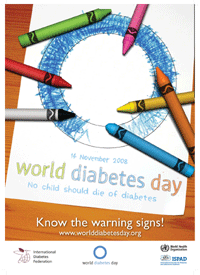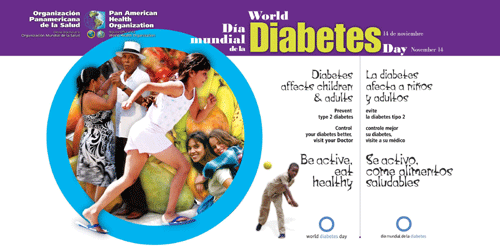World Diabetes Day: 14 November 2008

- PAHO Materials for the Americas
 Video, Press Release, and Comprehensive Information Resources: English | translation of press release | español |
Video, Press Release, and Comprehensive Information Resources: English | translation of press release | español |
Banners: Spanish-English | high resolution |
Posters: English | español | portugués | Booklet |
Brochure: español | Fact Sheets:
Basic Facts on diabetes (PDF) | español |
Ten Misconceptions about Diabetes (PDF | español) |
Indexes: PAHO Diabetes Page (surveillance, reports, surveys) | WHO- Worldwide WDD Website (in English, with many multilingual materials):
- Logos: English | español | português | français | Nederlands |
- Materials | Posters | Worldwide Activities | Media Center
|
Diabetes: PAHO urges fight against obesity and malnutrition in the Americas The prevalence of diabetes in the countries of Latin America and the Caribbean is growing at an alarming rate in epidemic proportions. The child and adolescent population is not safe from this and requires preferential attention in terms of strategies for support, care, and prevention. Washington, DC, 12 November 2008 (PAHO)-In the majority of the countries of the Americas, changes are taking place in dietary habits, with spiraling increase in the consumption of food with a dense caloric content and rich in saturated fats, sugars, and salts. This model, said Dr. Alberto Barceló, Regional Advisor on Chronic Diseases of the Pan American Health Organization (PAHO)—together with a growing culture of a sedentary lifestyle and a lack of physical activity–is contributing seriously to the increase that we are observing in the right rates of overweight and obesity in the Region. "The obesity epidemic, which is the cause of the increase in diabetes, is a major factor in the general move towards unhealthy eating habits and decreased physical activity This is especially serious in the child and adolescent population," affirmed Dr. Barceló in the celebration of World Diabetes Day on 14 November, the central theme for this year being—with the leadership of the International Diabetes Federation (IDF) with unconditional support from the entire United Nations system—an emphasis on the problem of diabetes in young people. The prevalence of obesity is on the increase among all age groups in the Americas, as well as in other regions of the world. Thus, studies on the problem in such countries as Chile or Mexico indicate that between some 7 and 12% of children under five and one fifth of all adolescents there are already obese. Among adults, it is estimated that the overweight and obesity rates are currently close to 60%. Data and estimates from WHO reveal that the number of persons suffering from diabetes in Latin America could reach 32.9 million by 2030. Right now, according to the available data, the highest prevalence rates for diabetes are in Belize (12.4%) and Mexico (10.7%). According to various studies and reports, some of the huge Latin American capitals like Managua, Guatemala City, and Bogotá are reporting prevalence rates of between 8 and 10%. With World Diabetes Day, PAHO unites with the IDF, and all organization and institutions around the world are urging decisive action to prevent and control diabetes, thus showing their support for all who suffer from this disease—especially young people, children, and adolescents. "To do nothing is not an option," emphasizes the IDF. Diabetes is a chronic lifelong condition that requires strict monitoring and control. Without adequate control, a person's blood sugar levels can increase, which is directly associated in the long run with wounds and organ and tissue failure. The IDF also reminds us that the following serious complications and risk can arise (among others):
The IDF explains the diabetes has a unique impact on children and their families since a child's daily life is changed by the need to monitor his or her blood sugar levels, by having to take medication, and by having to balance the effects of activity and eating. Diabetes, affirms the IDF, can interfere with the normal developmental needs of children and adolescents, which includes a successful education and transition to adulthood. In order to face this situation and to assure that they enjoy the highest level of physical and emotional health possible, children with diabetes should receive care from a multidisciplinary team very familiarized with its pediatric aspects. It is also necessary to help their caretakers and the staff in their schools. "In this way, children with types 1 or 2 diabetes can reach adulthood with minimal negative impact," affirms the IDF. "Physiological and social problems can prevent children from receiving the best available diabetes care available and from meeting their treatment objectives. Aside from the demanding physical and emotion challenges that go along with growth, diabetes imposes considerable—and sometimes overwhelming—demands on children and their families. The disease is unavoidable. It affects all aspects of a child's life and imposes a burden that must be borne by the child and his or her family, school, and local community. Diabetes control puts psychological pressure on children with diabetes and their family members, especially when its control and treatment are intensive." From PAHO, Dr. Barceló emphasized that hemispheric organization considers diabetes and other chronic diseases to be health priorities. This is why, he said, the 48thPAHO Directing Council in 2008, in its annual meeting of ministers of health from its Member States, approved resolution calling for the countries of the Americas to strengthen their diabetes prevention and control activities. "This resolution is based on the evidence that both type 2 diabetes and some of its complications can be prevented by public health actions aimed at individuals or communities," affirmed Dr. Barceló. "Because of this, PAHO is providing technical collaboration to many countries to reinforce prevention and improve diabetes care. One of these programs is the VIDA project carried out in Veracruz, Mexico. This program has shown favorable results and has become an inspiration for many of those affected by the disease as well as for professionals, in the continuing struggle to fight this disease." (For more on the VIDA project, watch the video (in Spanish) offered as part of the press release.) |
Basic Facts on Diabetes (PDF | español)

- Diabetes affects 246 million people throughout the world and this figure will reach 380 million by the year 2050.
- Seven million people develop diabetes each year.
- Every ten seconds somebody dies from causes associated with diabetes.
- Every ten seconds two people develop diabetes.
- In many countries of Asia, the Middle East, Oceania, and the Caribbean, diabetes affects between 12 and 20% of the adult population.
- Seven of the 10 countries with the highest rates of people living with diabetes are in the developing world.
- By the year 2050, 80% of diabetes cases will be in middle- and low-income countries.
- India has the largest population with diabetes in the world, with an estimated 41 million people (6% of the adult population).
- Type 1 diabetes, with predominantly affects young people, is increasing at an alarming rate throughout the world, at a rate of 3% annually.
- Some 70,000 children under 14 develop type 1 diabetes every year.
- An increasing number of children is developing type 2 diabetes both in developed and developing countries.
- Type 2 diabetes is already being reported in children as young as eight years of age.
- Various reports show the existence of type 2 diabetes in child populations previously thought not to be at risk of contracting the disease.
Source: Diabetes Atlas, (3rd ed.), International Diabetes Federation (2006).
Ten Misconceptions on Diabetes | (PDF | español)
- 1. Diabetes is not a disease that kills: FALSE
- In fact, diabetes is a global killer that rivals HIV/AIDS in its deadly reach. The disease kills some 3.8 million people every year. Every 10 seconds somebody dies from causes related to diabetes.
- 2. Diabetes only affects the rich countries: FALSE
- Diabetes is everywhere and is beyond national income. Currently more than 240 million people have diabetes. In many countries of Asia, the Middle East, and the Caribbean, diabetes affects between 12 and 20% of their populations. And by 2025, 80% of all cases will be in low- and middle-income countries.
- 3. Diabetes can count on robust global funding: FALSE
- Official foreign aid (from the USA) for the health sector in 2002 reach 2.9 billion dollars (US), of which hardly 0.1% were allocated to financing ALL chronic noncommunicable diseases (CNCDs). Most of these 2.9 billion dollars was used to fight the challenge of HIV/AIDS. Despite the fact that diabetes has a global impact and mortality comparable to HIV/AIDS, its funding was a meagre 0.1% of all funding for CNCDs.
- 4. Diabetes care is not expensive: FALSE
- Diabetes care is indeed costly and potentially could seriously affect any healthcare system. The economic opportunities that the United Nations wants to create for the developing countries through its Millennium Development Objectives (MDGs) are seriously countered by the economic impact of diabetes in low- and middle-income countries.
- 5. Diabetes only affects the elderly: FALSE
- In reality, diabetes affects all age groups. It is currently estimated that 246 million people in the age group from 20 to 79 years will get diabetes. In the developing countries, diabetes affects at least 80 million people between 40 and 59 years of age. In many countries of Asia, the Middle East, Oceania, and the Caribbean, diabetes affects between 12 and 20% of the adult population.
- 6. Diabetes predominantly affects men: FALSE
- In fact, diabetes is growing among both men and women, affecting slightly more women than men.
- 7. Diabetes is not preventable: FALSE
- Even if it is true that type 1 diabetes is not preventable, nearly 80% of type 2 diabetes can be prevented with a health diet and by increasing physical activity and promoting healthy lifestyles.
- 8. Diabetes is the result of unhealthy lifestyles: FALSE
- The truth is that poor people and children have limited options when it comes to their living conditions, diet, and education.
- 9. Diabetes prevention is too expensive: FALSE
- There are many interventions that are not expensive for cost-effective prevention. Strategies of proven efficiency, such as improving people's living conditions, changes in diet, and an increase in physical activity can reverse the epidemic.
- 10. We all have to die from something. TRUE, but …
- Death is an inevitable fact of life, but it does not have do be a slow, painful, or premature one. Diabetes causes 3.8 million deaths every year. With awareness, prevention, and appropriate care, many of these deaths can be avoided.
Source: Diabetes Atlas, (3rd ed.), International Diabetes Federation (2006), based on the World Health Organization (WHO) report, Preventing Chronic Disease: A Vital Investment.
